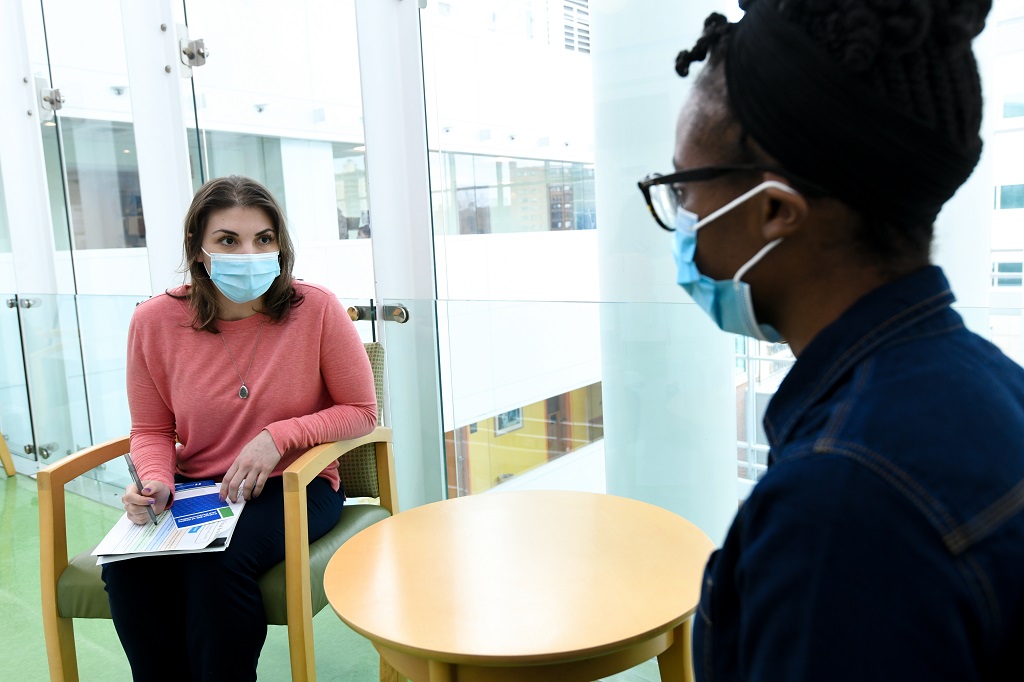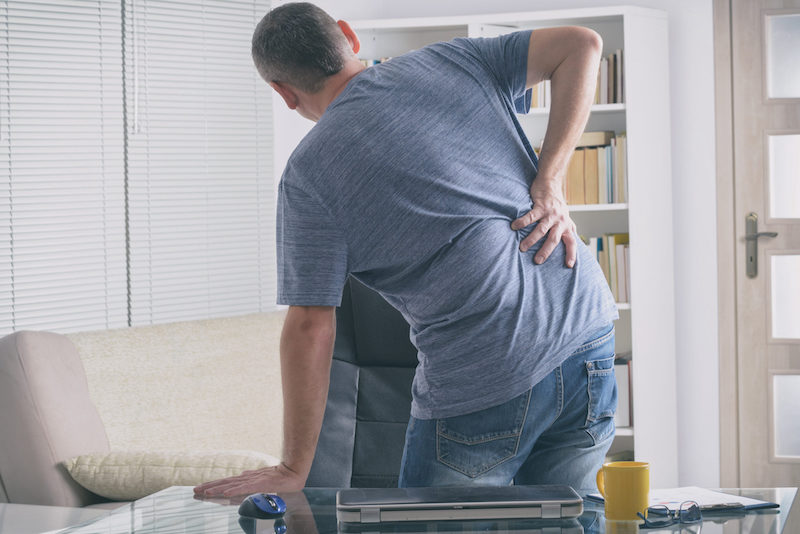6 Ways to Alleviate Lower Back Pain During Lockdown

April 27, 2020
By Brianna McCabe
Binge watching movies from a fixed position on your bed all day, every day seems like it may very well be the only option to help you power through the coronavirus pandemic while staying at home… but did you know that doing this for too long can potentially lead to body stiffness and increased lower back pain?
According to Sagar Parikh, M.D., an interventional pain medicine specialist at JFK Johnson Rehabilitation Institute, about 80% of adults experience lower back pain at some point during their lifetimes due to common causes including:
- Lower back strain
- Arthritis
- Degenerative disc disease
- Improper spine alignment and stability
- Herniated disc
- Radiculopathy or sciatica (pain from the back radiating down the leg)
- Spinal stenosis
- Fracture
- Other causes related to the musculoskeletal system (the body’s form, support, stability and movement mechanisms)
“And now more than ever with this lockdown, people need to get creative to try to prevent and/or alleviate back pain at home,” says Dr. Parikh.
At-home lower back pain therapies
Dr. Parikh advises the following six tips for patients dealing with lower back pain at home:
- Limit your bed rest. If you have lower back pain, Dr. Parikh recognizes that a person’s first instinct may be to lay in bed or sitting for long periods of time. “This does more harm than good, though” warns Dr. Parikh. “This can lead to serious stiffness and a long-term increase in pain.” In fact, he notes that prolonged bed rest can amount to loss of about 1% of muscle strength each day. “The sooner you start moving or even engaging in light to moderate exercise, the faster you may improve overall,” the expert adds.
- Get active! Maintenance of physical activity is essential to treating and/or preventing back pain. “At the most basic level, that means standing, walking and limiting sitting/lying down throughout the day,” he explains. “But if you want to take it to the next level and push your body, try incorporating aerobic activity like jump roping, jogging, dancing (Zumba) or even kickboxing.”Dr. Parikh also recommends incorporating strength training workouts to target the core and hips, such as fire hydrants, superman’s and planks. Many exercises can be found on free home exercise apps, such as 7 Minute Workout or Nike Training Club, along with the proper techniques.
- Apply ice or heat therapy. According to Dr. Parikh, heat therapy tends to help relax muscle tissue and relieve back pain. “That being said, though, many patients need to take a personalized approach to heat or ice with respect to their pain complaints,” he shares.
- Stretch. “This one is a bit tricky as stretching is extremely specific to each patient,” advises Dr. Parikh, “but if you were given specific stretches to do daily by your physical therapist or trainer, make sure that you are taking the time to do this.”
- Be mindful of what you’re eating. Excess weight around the mid-section can be especially strenuous for your lower back. Some foods to avoid overly eating would include:
- Sugary drinks
- Processed snacks (potato chips) and baked goods
- High-fat dairy products (ice cream)
- Constant take-out from restaurants
- Fried food
- Fruits
- Vegetables
- Beans and legumes
- Lean poultry and fish
- Healthy fats (coconut oil)
- Improve your posture. “This is a simple but very important way to keep the back and spine healthy,” shares Dr. Parikh. Some simple techniques include:
While some foods to try to incorporate more often into your meals would include:
“To avoid overeating or over-snacking, try to plan ahead with healthy meals, set a schedule of when you are going to eat each day and limit giving in to cravings (though it’s okay to give in every now and then!),” Dr. Parikh explains.
- Being mindful of sitting up straight when standing or sitting (and avoiding that slouch!)
- Keeping a pillow or rolled-up towel placed behind the lower back while sitting
- Keeping feet elevated on a low stool or a stack of books to relieve pressure from the back during prolonged periods of sitting
- Switching sitting positions often and periodically
When should I seek help for my lower back pain during the lockdown?
If your lower back pain becomes so ‘all-consuming’ that you cannot function, Dr. Parikh advises calling your doctor. Additionally, he advises seeking immediate medical attention if you experience any of the following symptoms along with your back pain:
- Weakness in your legs
- Incontinence (inability to control urination)
- Pain waking you from your sleep
- Fever
- Chills
- Numbness below the waistline
Next Steps & Resources:
- Meet our clinical contributor: Sagar Parikh, M.D.
- To make an appointment with Dr. Parikh or a doctor near you, call 800-822-8905 or visit our website.
The material provided through HealthU is intended to be used as general information only and should not replace the advice of your physician. Always consult your physician for individual care.
Find a doctor near me
When to Apply Ice Vs. Heat Packs

Learn when to use ice or heat packs for pain relief. Dr. Rama explains cold vs. heat therapy for injury and chronic pain. Get relief; call 800-822-8905.
How to Strengthen Your Back and Avoid Injury

Strengthen your back & avoid injury. Learn expert tips from Dr. Tawfik at Ocean Medical Center for better posture, healthy habits, and spine health.
Find a doctor near me

Staying Connected While Social Distancing Is Important, Here’s Why
Social distancing is an important way to slow down the spread of the COVID-19. But for many, keeping distance from other people can feel isolating and lonely.

Can COVID-19 Cause Back Pain?
COVID-19 may cause back pain. Drs. Parikh & Fleming explain causes and prevention. Learn back pain treatment options and find a specialist.

Should You Wear a Mask Outside?
Should You Wear a Mask Outside? Dr. Frank explains when masks are needed in New Jersey and offers guidance on COVID-19 safety. Learn more & schedule an appointment.

